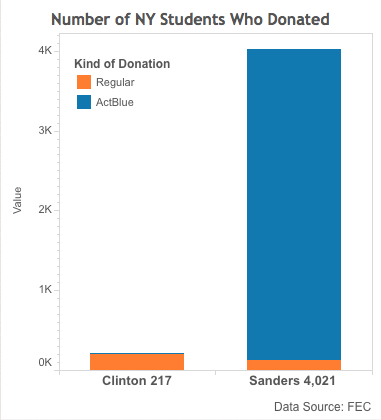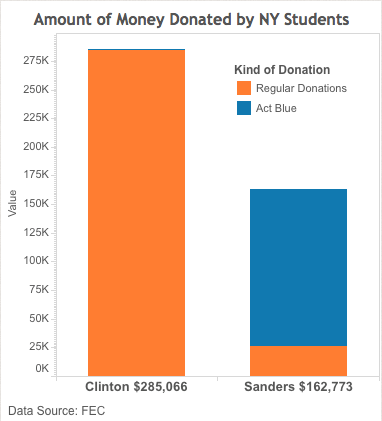
Much has been said about the tremendous support Bernie Sanders has among young people. Take the New York primary: While Sanders lost by 16% in total, he received 65% of the young vote (the 18 to 29-year olds), according to exit polls.
Judging from this, a vast majority of college-aged New Yorkers voted for Sanders.
In New York, the Brooklyn-native also received a high amount of donations from students. But they didn’t have the same impact as those Hillary Clinton received from the same group, as a Lady Liberty Votes-analysis of filings with the Federal Election Commission shows. (For a detailed description of my methodology, see the end of the article.)
Why Donate?
“I have the privilege of parents who support me through college and would rather use my money on making the world a better place than on tickets to the Senior Ball,” said Eric Wimer, a 22-year-old Columbia student, who regularly donates to the Sanders campaign.
He wasn’t the only young New Yorker who showed his support financially.
“Making donations can sometimes be tough for college students on a budget, but I feel that my contribution to Hillary Clinton’s campaign is an investment in the future,” said Jonathon Boyd, a 21-year old junior at New York University. Boyd gave $250, which also allowed him to hear Secretary Clinton speak at a fundraising event.
#FeelTheBern

At first glance, Clinton beats Sanders in the amount of donations: 216 New York students made contributions to her campaign, while only 127 gave to Sanders.
The picture changes drastically once you add donations processed through ActBlue – a democratic online fundraising site that is especially popular among Bernie Sanders supporters.
Now, it’s 4,021 students from New York who donated to Sanders compared to 217 for Clinton.
The pattern repeats itself in the number of total contributions these students made: Sanders got 9,185 individual donations, while Clinton received only 731.
That’s over twelve times as many contributions.
So, Sanders resoundingly won the race for most donations, but that doesn’t mean he also received more money.
#ImWithHer
 Even though Hillary Clinton received only 8% as many contributions as Sanders did, she still got tens of thousands of dollars more.
Even though Hillary Clinton received only 8% as many contributions as Sanders did, she still got tens of thousands of dollars more.
In total, the New York students transferred $285,066 to the Clinton campaign compared to only $162,773 that Sanders’ camp received.
That are over 122 thousand more dollars that Clinton got from students in New York.
The big difference stems from the amount of money the young voters donated. Clinton received 75 donations that reached the legal maximum of $2,700, an astounding number considering that the money came from students.
In comparison, only two New York students gave the same amount to Sanders.
Meredith Doherty came close – she transferred $2,272 to the Sanders camp – but it wasn’t even her own money. “We raised the money I donated with a massive music and performance art dance party,” said Doherty, a PHD student at the City University of New York.
Size of Donations
The value of campaign donations is not only hard money; there is also the power of perception.
“The media often celebrates candidates who are able to capture young/small-scale donors as populist candidates,” said Caitlin Rose Walker, a 29-year old Clinton supporter and graduate student at Columbia.
“My contribution may not be much in terms of dollars, but it shows my commitment to her campaign as a young person and a student,” she said. Walker has donated several hundred dollars in $25 increments over the last six months.
For Bernie Sanders it’s all about $27. That’s the size of his average donation and he has repeated the number so often in his speeches that the audience finishes it for him at his rallies. The New York students underscored his national average, their average donation was $17.72.
Ned Crowley, a-27 year old sociology major at New York University, is proud to be part of the millions of Americans who make small contributions to Bernie. “By defying expectations, he’s shown ordinary folks that presidential elections are not all decided in advance by the billionaire class,” Crowley said.
The smallest contribution Hillary Clinton received from a New York student totaled only 24 cents, but in general the size of her donations was much higher. On average she received $ 390 from the young New Yorkers.

In the end: $120,000 more
Throughout the whole country, Bernie Sanders has outraised his primary opponent Hillary Clinton for the third month in a row. But an analysis of donations made by politically-minded students in New York showed that this isn’t always the case.
Almost twenty times as many students donated to Bernie Sanders in New York as they did to his opponent Hillary Clinton. They made over ten times as many contributions.
And yet, Hillary Clinton received over $120,000 more.
It’s only a small group of people in one of many states, but it shows that Sanders’ much-lauded small donations aren’t always a match for Clinton’s more generous donors. And that energizing the masses doesn’t automatically mean that all young people are #FeelingTheBern.
But regardless of who won the money race, both Sanders and Clinton managed to get young voters involved in politics. In total, students from New York gave an astounding amount of almost $450,000 to the Democratic candidates.
Nerd Box – How I did it
For this story, I analyzed the most recent filings of the Sanders and the Clinton campaign with the Federal Election Commission. I only looked at contributions to the candidates themselves (and not their super PACs) and only at so-called “itemized individual contributions” that include specific information about the donors. (Donations under $200 don’t require donors to include personal information.)
The FEC doesn’t ask donors for their age, so it’s impossible to look at the young vote by age. Instead I focused on people who used the words “student,” “graduate student” or “PHD” when they listed their occupation, but made sure to exclude variations like “student advisor” or “student dean.” I only looked at students who listed New York as their home state.
I found 518 donations by 127 individuals for Sanders and 730 donations by 216 individuals for Clinton.
A lot of contributions (especially to the Sanders campaign) are processed through ActBlue. In FEC filings of the different campaigns, those donations generally have “ActBlue” as the name of the contributor and don’t include individual donor information. In order to get more specific data, I looked at ActBlue’s own FEC filings. The file was too big to be opened in a regular processor, so I used SQL and Command Line to extract only those donations made to Clinton and Sanders in New York.
For Clinton, I could only find one extra donation by a New York student, for Sanders it was 9,062 extra donations. But a comparison of the data sets showed that 395 of these ActBlue donations were already included in the original Sanders FEC file, so I removed the doubles.
In the end, I had a total of 9,185 contributions by 4,021 individual New York students to Sanders and a total of 519 donations by 217 New York students to Clinton. These were the basis for the analysis shown in this article.
